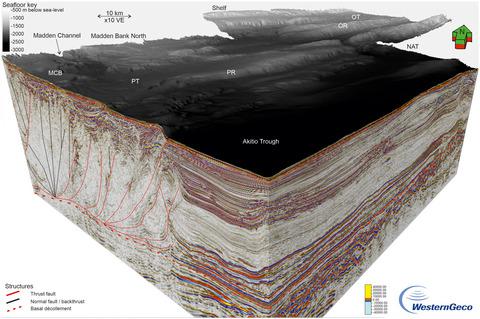当前位置:
X-MOL 学术
›
Basin Res.
›
论文详情
Our official English website, www.x-mol.net, welcomes your feedback! (Note: you will need to create a separate account there.)
Sedimentation on structurally complex slopes: Neogene to recent deep-water sedimentation patterns across the central Hikurangi subduction margin, New Zealand
Basin Research ( IF 3.2 ) Pub Date : 2022-06-10 , DOI: 10.1111/bre.12686 A. D. McArthur 1 , A. Crisóstomo‐Figueroa 1 , A. Wunderlich 2 , A. Karvelas 3 , W. D. McCaffrey 1
Basin Research ( IF 3.2 ) Pub Date : 2022-06-10 , DOI: 10.1111/bre.12686 A. D. McArthur 1 , A. Crisóstomo‐Figueroa 1 , A. Wunderlich 2 , A. Karvelas 3 , W. D. McCaffrey 1
Affiliation

|
Deep-water sedimentation on active margins often entails complex sediment transport pathways through slope accommodation. Sedimentation in such settings is commonly differentiated into ‘fill and spill’ vs. ‘tortuous corridor’ models. To investigate the utility of these models in convergent settings 15,344 km2 of 3D seismic data is used to investigate sedimentation and erosion patterns across the Hikurangi subduction margin. A series of thrust-bound trench-slope basins, each tens of kilometres long by kilometres wide, have been diachronously forming, filling and deforming through the Neogene until today. Five primary input points delivered sediment to the basins along the studied part of the margin. Channels display both axial and transverse orientations, the run-out lengths of which vary temporally. At various times, relatively coarse-grained sediment was trapped in the interior basins, occasionally then to be cannibalised during landsliding or erosion of growing structures. At other times, coarse-grained sediment was bypassed to distal basins or the trench. Multiple sediment input points and occasionally tortuous sediment dispersal corridors result in the evolution of convoluted depositional systems, often with similar styles of sedimentation occurring contemporaneously in proximal and distal basins, contrary to simple models of basin fill. A hierarchy of controls on sediment distribution can be distinguished. At the highest level, sediment distribution is controlled by external factors, for example, glacio-eustacy and tectonics. At basin scale, the interaction of sedimentary systems with local relief (e.g. evolving seafloor structures and landslides) dictates the location and style of deposition. At the lowest level, autocyclic factors (e.g. flow response to earlier deposits) influence the spatiotemporal variation in erosion and sedimentation. The complex interplay of these factors dictates whether basins were filling, spilling or some combination at any point in time, whilst basins that were filled and spilled may subsequently resume filling due to changes in the bounding conditions. Hence simple use of ‘fill and spill’ or ‘tortuous corridor’ models to tectonically active margins is not advised. Furthermore, as sedimentation may influence structure growth, constraining the controls on sediment distribution may improve understanding of the broader evolution of convergent margins and their resource distribution.
中文翻译:

结构复杂斜坡上的沉积:新西兰 Hikurangi 中部俯冲边缘的新近纪到最近的深水沉积模式
活动边缘的深水沉积通常需要复杂的泥沙输送路径通过斜坡调节。这种环境中的沉积物通常分为“填充和溢出”与“曲折走廊”模型。研究这些模型在收敛环境中的效用 15,344 km 23D 地震数据用于研究 Hikurangi 俯冲边缘的沉积和侵蚀模式。直到今天,一系列以逆冲为界的沟槽斜坡盆地,每一个长几十公里,宽几公里,一直在穿过新近纪进行穿时形成、充填和变形。五个主要输入点将沉积物输送到边缘研究部分的盆地。通道显示轴向和横向方向,其跳动长度随时间变化。在不同的时期,相对粗粒的沉积物被困在内部盆地中,偶尔会在山体滑坡或生长结构的侵蚀过程中被蚕食。在其他时候,粗粒沉积物被绕过到远端盆地或海沟。多个沉积物输入点和偶尔曲折的沉积物扩散走廊导致了复杂沉积系统的演变,与盆地填充的简单模型相反,近端和远端盆地通常同时发生类似的沉积方式。可以区分对沉积物分布的控制层次。在最高层,沉积物分布受外部因素控制,例如冰川-太平洋和构造。在盆地尺度上,沉积系统与局部地形(例如不断演变的海底结构和滑坡)的相互作用决定了沉积的位置和类型。在最低水平,自循环因素(例如对早期沉积物的流动响应)影响侵蚀和沉积的时空变化。这些因素的复杂相互作用决定了盆地是否在任何时间点被填充、溢出或某种组合,而被填充和溢出的盆地可能随后由于边界条件的变化而恢复填充。因此,不建议对构造活动边缘简单地使用“填充和溢出”或“曲折走廊”模型。此外,由于沉积物可能影响结构生长,限制对沉积物分布的控制可以提高对收敛边缘及其资源分布的更广泛演变的理解。因此,不建议对构造活动边缘简单地使用“填充和溢出”或“曲折走廊”模型。此外,由于沉积物可能影响结构生长,限制对沉积物分布的控制可以提高对收敛边缘及其资源分布的更广泛演变的理解。因此,不建议对构造活动边缘简单地使用“填充和溢出”或“曲折走廊”模型。此外,由于沉积物可能影响结构生长,限制对沉积物分布的控制可以提高对收敛边缘及其资源分布的更广泛演变的理解。
更新日期:2022-06-10
中文翻译:

结构复杂斜坡上的沉积:新西兰 Hikurangi 中部俯冲边缘的新近纪到最近的深水沉积模式
活动边缘的深水沉积通常需要复杂的泥沙输送路径通过斜坡调节。这种环境中的沉积物通常分为“填充和溢出”与“曲折走廊”模型。研究这些模型在收敛环境中的效用 15,344 km 23D 地震数据用于研究 Hikurangi 俯冲边缘的沉积和侵蚀模式。直到今天,一系列以逆冲为界的沟槽斜坡盆地,每一个长几十公里,宽几公里,一直在穿过新近纪进行穿时形成、充填和变形。五个主要输入点将沉积物输送到边缘研究部分的盆地。通道显示轴向和横向方向,其跳动长度随时间变化。在不同的时期,相对粗粒的沉积物被困在内部盆地中,偶尔会在山体滑坡或生长结构的侵蚀过程中被蚕食。在其他时候,粗粒沉积物被绕过到远端盆地或海沟。多个沉积物输入点和偶尔曲折的沉积物扩散走廊导致了复杂沉积系统的演变,与盆地填充的简单模型相反,近端和远端盆地通常同时发生类似的沉积方式。可以区分对沉积物分布的控制层次。在最高层,沉积物分布受外部因素控制,例如冰川-太平洋和构造。在盆地尺度上,沉积系统与局部地形(例如不断演变的海底结构和滑坡)的相互作用决定了沉积的位置和类型。在最低水平,自循环因素(例如对早期沉积物的流动响应)影响侵蚀和沉积的时空变化。这些因素的复杂相互作用决定了盆地是否在任何时间点被填充、溢出或某种组合,而被填充和溢出的盆地可能随后由于边界条件的变化而恢复填充。因此,不建议对构造活动边缘简单地使用“填充和溢出”或“曲折走廊”模型。此外,由于沉积物可能影响结构生长,限制对沉积物分布的控制可以提高对收敛边缘及其资源分布的更广泛演变的理解。因此,不建议对构造活动边缘简单地使用“填充和溢出”或“曲折走廊”模型。此外,由于沉积物可能影响结构生长,限制对沉积物分布的控制可以提高对收敛边缘及其资源分布的更广泛演变的理解。因此,不建议对构造活动边缘简单地使用“填充和溢出”或“曲折走廊”模型。此外,由于沉积物可能影响结构生长,限制对沉积物分布的控制可以提高对收敛边缘及其资源分布的更广泛演变的理解。


























 京公网安备 11010802027423号
京公网安备 11010802027423号